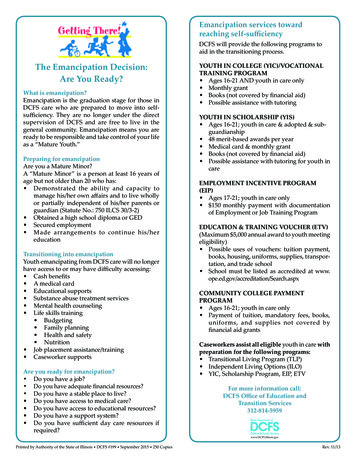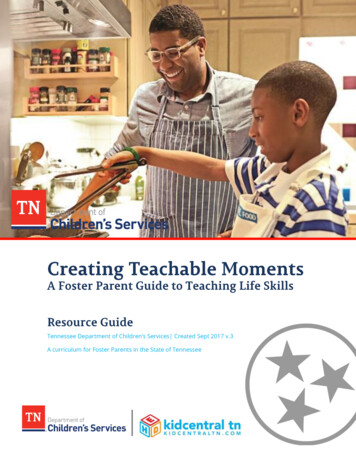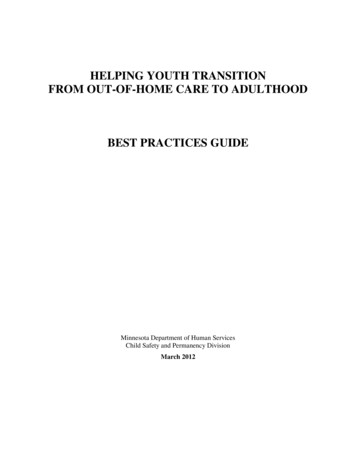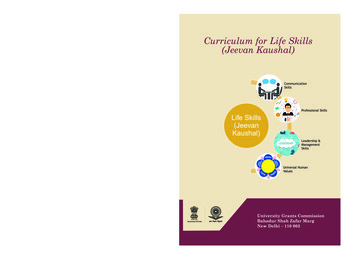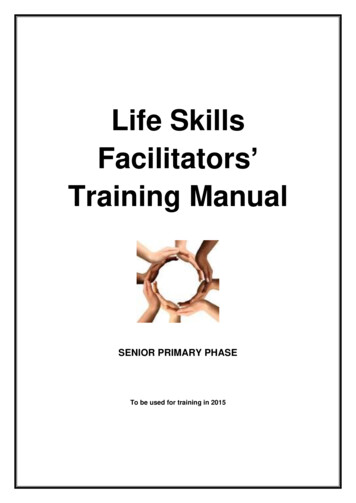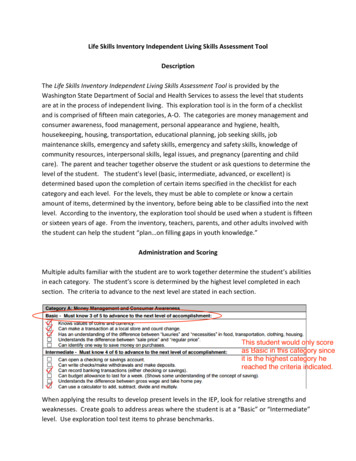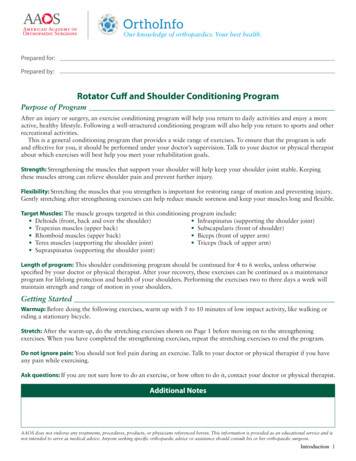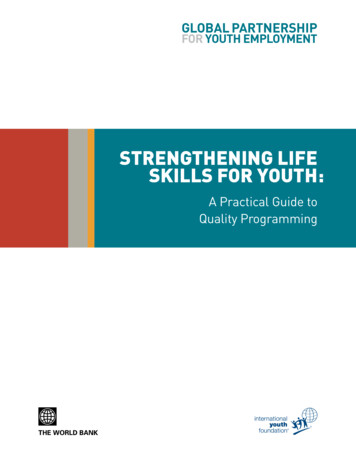
Transcription
GLOBAL PARTNERSHIPFOR YOUTH EMPLOYMENTStrengthening LifeSkills for Youth:A Practical Guide toQuality Programming
about gpyeWith support from the World Bank Development Grant Facility, in 2008 the International Youth Foundation, the YouthEmployment Network, the Arab Urban Development Institute, and the Understanding Children’s Work Project joinedtogether to form the Global Partnership for Youth Employment (GPYE). Its goal: to build and disseminate evidence onyouth employment outcomes and effective programs to help address the challenges facing young people in their transitionto work. The GPYE leverages the technical and regional experience of its five partner organizations in youth employmentresearch, programming, evaluation, and policy dialogue. The partnership’s work focuses on Africa and the Middle East, regionsin need of better evidence on effective approaches to youth employment. This report is one in a series of assessments, researchstudies, technical guides, and learning papers produced by the GPYE to build the evidence base for improving policies,program design, and practices related to youth employability in the region. These resources can be accessed at www.gpye.org.The World Bank supports governments in developing countries on a wide range of child and youth development issues,including youth employment, by conducting research, financing projects and supporting rigorous evaluation. Learn more atwww.worldbank.org/childrenandyouth.The International Youth Foundation (IYF) invests in the extraordinary potential of young people. Founded in 1990, IYFbuilds and maintains a worldwide community of businesses, governments, and civil-society organizations committed toempowering youth to be healthy, productive, and engaged citizens. IYF programs are catalysts of change that help young peopleobtain a quality education, gain employability skills, make healthy choices, and improve their communities. To learn more, visitwww.iyfnet.org. 2014 International Youth Foundation (IYF). All rights reserved.No portion of this report may be reproduced without prior written permission from IYF.
Strengthening LifeSkills for Youth:A Practical Guide toQuality Programming
ii International Youth Foundation
ContentsGuidelines for Usage1Table 1: Life Skills Standards of ExcellenceImportance of Life Skills23Table 2: Status of Life Skills Training Programs in MENA Compared with Minimum StandardsSection 1: Curriculum Design67Table 3: Minimum Life Skills by Youth CohortChecklist of Curriculum Committee TasksSection 2: Curriculum Adaptation81213Table 4: Comparison of Curriculum Creation and AdaptationGuidelines for Ensuring Life Skills Curricula are Culturally AppropriateSection 3: Trainer Selection141718Table 5: Minimum Qualifications for Life Skills TrainersInterview Questionnaire for Life Skills TrainersSection 4: Training of Trainers192021Table 6: Basic TOT Components24Section 5: Mentoring Trainers26Section 6: Interactive Teaching Methodologies30Table 7: Instructional Tools by Learning StyleSection 7: Training Schedule3336Table 8: Life Skills Program Structure by Delivery Type38Section 8: Classroom Environment40Section 9: Monitoring and Evaluation43Table 9: M&E Through the Program Life CycleM&E Tools and Performance g Life Skills for Youth: A Practical Guide to Quality Programming iii
Guidelines for UsageThis Life Skills Guide is a practical tool to help users – donors and youth serving organizations - enhance the design,planning, implementation, and evaluation of life skills programming and training based on a set of nine Life SkillsStandards of Excellence (listed below). These standards have been developed by the International Youth Foundation(IYF) and its partners around the world based on more than a decade of experience in the life skills arena.We hope that this guide can help to steer users through a strategic assessment of your current life skills offerings, aswell as provide ideas and examples to assist your organization in enhancing overall life skills program quality, to theultimate benefit of the young people all of us serve. As our goal is to help disseminate best practices worldwide, weencourage you to use and share this guide widely with organizations in your network.Who should use this guide?This guide is intended for any organization that works with youth (aged 15-29), as well as the donors that support thiswork. It was created based on IYF’s work with organizations around the world, conversations with donors supportingand implementing life skills programs, and IYF’s extensive experience implementing the Passport to Success (PTS)curriculum globally. Based on our regular consultations with a large number of stakeholders on how to effectively design,implement, and evaluate life skills programs, we created this guide to share our knowledge in a structured manner.Thus the Life Skills Guide can be used by both donors and youth organizations. We expect that it will be useful inthe following ways:Donors can integrate Standards of Excellence for life skills into requests for proposals to set expectationsfor quality, and consequently can assess proposals according to these standards.Youth Organizations can evaluate and improve their existing life skills programs, or if they have notoffered such programs before, design and adapt new programming to meet high quality standards.Target youth for life skills training may be in secondary schools or universities, in non-formal education settings, invocational or professional training programs, or already employed or self-employed. Or they may not be benefittingfrom any of the above services, with life skills training being the first support service they have received. Finally, lifeskills have proven particularly effective for highly vulnerable youth and at-risk populations such as illiterate youth,refugees, and those with physical handicaps.The types of life skills programs that can benefit from these Standards of Excellence include the following: Stand-alone life skills training for various youth populations On-the-job training for employees Programs within: Formal schooling (middle school, high school, or university) Vocational or professional training Employability or entrepreneurship training for youth seeking workStrengthening Life Skills for Youth: A Practical Guide to Quality Programming 1
How to use this guideTo help lead youth organizations and life skills practitioners through assessing and revising their life skillsprogramming, this guide is organized into nine sections each covering one of the Standards of Excellence. TheStandards of Excellence are organized into four components as outlined in the table below and provide simple, easyto understand suggestions for how to effectively plan, design, implement, and evaluate life skills programs.Table 1. Life Skills Standards of ExcellenceLife Skills Standards of ExcellenceArea I: Selecting a life skills program curriculum and engaging relevant stakeholders1. Core life skills competencies are included and key stakeholders’ needs are addressed during the curriculumdesign process2. The curriculum is adapted and piloted to ensure it is appropriate for the target audienceArea II: Selecting and training life skills facilitators3. Clearly defined criteria are consistently used throughout the trainer selection process4. A robust Training of Trainers is offered to prepare and develop dynamic facilitators5. A mentoring system is created to support life skills trainers’ continuing developmentArea III: Creating an environment conducive to life skills learning6. Interactive, participatory, and practical teaching methodologies and tools are used7. Adequate time is allowed for each life skills lesson within a well-paced schedule8. An effective and comfortable learning environment is created for all participantsArea IV: Monitoring and evaluating a life skills program9. Life skills training is adequately monitored and evaluated to improve program outcomesEach Standard of Excellence represents an important step in the planning and implementation of a life skillstraining program. In each section of this guide, the Standard of Excellence is briefly explained. This is followed bya description of the content of the Standard and practical guidance for putting it into effect. Checklists and otherpractical tools should help you navigate the key information quickly.We hope that you find these Standards of Excellence and accompanying guidelines valuable and practical as youdevelop or enhance your life skills programming. Congratulations for taking this important first step to improve thelife skills – and by extension the conditions and prospects – of youth.2 International Youth Foundation
Importance of Life SkillsBefore exploring each of the Standards of Excellence in depth, this introductory section will provide an overview of lifeskills training and the evidence for its role in improving youth outcomes, both personal and professional. It will alsobriefly discuss IYF’s experience in assessing life skills programs globally, which has given rise to the creation of this guide.Defining life skillsOver the past two decades, educators, employers, and policymakers have increasingly placed great emphasis on thedevelopment of life skills as a way to prepare young people for success in today’s rapidly changing and globalizedworld. However, the range of how different organizations define life skills is vast.1 For example, the WHO hasdefined life skills as “abilities for adaptive and positive behavior that enable individuals to deal effectively with thedemands and challenges of everyday life2,” while UNICEF has defined them as a “large group of psychosocial andinterpersonal skills that can help people make informed decisions, communicate effectively, and develop coping andself-management skills that may help lead a healthy and productive life.”3However, all of these definitions have several elements in common, including the psychosocial, interpersonal, andemotional nature of life skills, as well as their function in enabling youth to overcome challenges, act positively, anddevelop to their fullest potential. To synthesize these varying definitions for the purposes of this guide, we refer tolife skills as the following:Life skills are a comprehensive set of universal cognitive and non-cognitive skills and abilities, connecting behavior,attitudes, and knowledge, which youth can develop and retain throughout their lives. Life skills increase youngpeople’s well-being and help them to develop into active and productive members of their communities.Life skills as the key to success for today’s youthAlthough young people around the world are more and more likely to pursue formal education, upon graduationthey often find that they are not adequately prepared for the world of work. Because skills relevant to key growthsectors of the modern economy – both technical and “soft” skills – are often not covered in traditional educationsystems, employers often find a “skills mismatch” between the competencies youth need to succeed in the workplaceand those they actually possess.4 This is a critical challenge for today’s youth, and one key approach to overcomingthis challenge is through the provision of life skills training.The skills mismatch has continued to grow with globalization and as many countries transition to a moreservice-oriented economy. Employers are finding that regardless of their level of education, most new hires lackcommunication and client-relations skills; organizational and prioritization skills such as time-management; and1For an in-depth comparison and analysis of the concept and definitions of life skills, see Jacobs Foundation (2011). Guideline on Monitoring and Evaluating Life Skills for Youth Development, Volume 1, pp. 9-14.2 World Health Organization (1997). Life Skills Education for Children and Adolescents in Schools. Introduction and Guidelines to Facilitate the Developmentand Implementation of Life Skills Programs. World Health Organization - Programme on Mental Health. Doc. WHO/MNF/PSF/93.7A.Rev.2. Geneva:World Health Organization, p. 1.3 UNICEF (2012). Evaluation Report: Global Evaluation of Life Skills Education Programs, pp. vi, viii, 1, and 7.4 IYF (2013a). Creating Opportunities for Youth in Hospitality, pp. 5-6. See also IYF (2012). Opportunity for Action: Preparing Youth for 21st CenturyLivelihoods.Strengthening Life Skills for Youth: A Practical Guide to Quality Programming 3
flexibility and adaptability.5 Entry-level employees in many emerging markets may be technically overqualified, butlack teamwork and interpersonal skills, making collaboration with colleagues and problem-solving between teammembers difficult.This problem holds in all regions of the world. In Latin America and the Caribbean, a lack of vocational and softskills desired by businesses is contributing to high rates of youth unemployment, while in Central and EasternEurope, 40 percent of private-sector employers report that low skill levels – particularly life skills – in the workforceare a constraint on economic growth.6 In the Middle East and North Africa region, the World Bank reports thatthe transition period from school to work lasts longer than in other emerging economies, and the rising skills gap,between what employers see as crucial skills for a successful career and the skills youth have, is an enduring labormarket issue.7These challenges are particularly important in light of the “youth bulge” – a peak number of young people aged15-24 – projected in the next several decades in almost all developing countries. This can create a window ofopportunity for economic growth by tapping into the potential for increased productivity and higher earnings foryoung people – but only if they are adequately equipped for the modern labor market.8 Hence, it is imperative thatglobal and national economies be ready to reap the benefits of this demographic trend and ensure that all youth havethe opportunity to succeed.There is growing awareness of the need for life skills training to help youth manage the transition from school towork and become active, healthy citizens. Schools and universities are increasingly adding life skills as a part of theformal curriculum, as an afterschool activity, or as a part of career guidance services – often with the support ofyouth organizations that oversee or directly implement these training programs. In addition, employers who see aneed for improved life skills in their workplace, especially for entry-level employees, are increasingly turning to youthorganizations to provide youth with on-the-job training. These are promising developments and indicate the manyopportunities for youth organizations to cooperate with the public and private sectors for greater program impact.Evidence for life skillsThere is growing evidence that “both cognitive and non-cognitive abilities determine social and economic success”for young people and adults.9 As a result, comprehensive training programs that combine in-class employability andlife skills lessons with hands-on practical experience “have higher rates of success, with success defined as improvingthe probability of obtaining employment and/or higher earnings.”1056789104 IYF (2013b). Getting Youth in the Door: Defining Soft Skills Requirements for Entry-level Service Sector Jobs, pp. 4-5. See also IYF (2013c). A LaborMarket Assessment in Post-Revolution Egypt: Opportunities and Challenges for the Future, p. 8.IYF (2012), p. 2 and 6.Angel-Urdinola, Diego F., Semlali, Amina and Brodmann (2010). Non-public Provision of Active Labor Market Programs in Arab-MediterraneanCountries: An Inventory of Youth Programs, p. 1.Assaad, Ragui and Farzaneh Roudi-Faimi (2007). Youth in the Middle East and North Africa: Demographic Opportunity or Challenge?, p. 3.Heckman, James J., Stixrud, Jora and Sergio Urzua (2006). The Effects of Cognitive and Noncognitive Abilities on Labor Market Outcomes and SocialBehavior, p. 28.Angel-Urdinola, Diego F., Kuddo, Arvo and Amina Semlali, eds. (2013). Building Effective Employment Programs for Unemployed Youth in theMiddle-East and North Africa. Directions in Development, p. 17.International Youth Foundation
Life skills programs targeting youth in low- and middle-income countries have been shown to: Improve economic outcomes for youth: Life skills programs have been shown to increase the earningpotential of young people.11 In addition, they position youth to obtain jobs of better quality and formality,measured by written contracts and employer-paid insurance.12 Improve education outcomes for youth: Recent research has demonstrated that when young people areprovided interventions that include non-academic supports in social-cognitive skills, learning outcomesimprove as do completion/graduation rates. 13 Increase employer satisfaction with new hires: Life skills programs strengthen young people’s abilities inmany areas that employers consider particularly important when hiring new employees. Employers often reporta higher level of satisfaction with entry-level employees who have gone through life skills training than thosewho have not.14 Change personal behavior and social attitudes of youth: Life skills programs allow youth to create a life planand equip them with the skills to take steps toward achieving their goals. They also help young people to betterunderstand healthy personal behaviors, thus decreasing outcomes such as teen pregnancies, drug and alcoholuse, and interpersonal violence. As a result, they help to increase young people’s sense of self-esteem andexpectations for their future and the future of their children.15These findings are very encouraging and demonstrate that quality life skills programming can contribute to a “winwin” situation by addressing both youth and employers’ needs.Assessing the quality of life skills programsAlthough an ever-increasing number of youth organizations, schools, and companies are offering life skills trainingfor young people, these programs vary widely in scope, methodology, and quality. In a number of countries aroundthe world, IYF has conducted assessments of existing life skills programs and found that high standards of qualityare not always met. For example, a recent assessment of 57 life skills programs across the Middle East and NorthAfrica (MENA) region found that only two out of the 10 minimum standards used in that study were met in full.16The results of that assessment are shown in the table following:111213141516Ibarraran, Pablo, Ripani, Laura, Taboada Bibiana, Villa, Juan Miguel and Brigida Garcia (2012). Life Skills, Employability and Training forDisadvantaged Youth: Evidence of a Randomized Evaluation Design, pp. 5 and 21.Ibarraran et al. (2012), p. 21.Cook, P., Dodge, K., Farkas, G., Fryer, R., Guryan, J., Ludwig, J., Mayer, S., Pollack, H., Steinberg, L. (2014). The (Surprising) efficacy of academic andbehaviorial intervention with disadvantaged youth: Results from a randomized experiment in Chicago. National Bureau of Economic Research. WhitePaper 19862.IYF (2008), pp. 42-43.Ibarraran et al. (2012), pp. 23-24. This large randomized impact evaluation looked at the labor market outcomes of the Dominican youth trainingprogram Juventud y Empleo targeting disadvantaged youth. According to ILO, “life skills contribute to a systematic development of attitudes; knowledgeand skills patterns required for a job” and “enhance the abilities of trainees to [ ] translate technical skills into employment.” See Lobner, Sabine(1997). Life Skills for the World of Work: Experiences in South Africa, p. 1.Benson, P. L., & Scales, P. C. (2011). Developmental assets. In R. J. R.Levesque (Ed.), Encyclopedia of adolescence (pp. 667-683). New York: Springer. Duckworth, A. L., Peterson, C., Matthews, M. D., & Kelly, D. R. (2007).Grit: Perseverance and passion for long-term goals. Journal of Personality and Social Psychology, 92(6), 1087-1101. MacCann, C., Duckworth, A. L., &Roberts, R. (2009). Empirical identification of the major facets of conscientiousness. Learning and Individual Differences, 19, 451-458.IYF (2013d). Preparing Youth for Success: An Analysis of Life Skills Training in the MENA Region.Strengthening Life Skills for Youth: A Practical Guide to Quality Programming 5
Table 2: Status of Life Skills Training Programs in MENA Compared with Minimum StandardsStandards metStandards somewhat metStandards not metThe time devoted to life skillstraining is of sufficient duration andfrequency.Life skills curriculum includes contentrelated to core life skills.Life skills curriculum responds toneeds identified by key stakeholders.The classroom or workshopenvironment is conducive to effectiveand comfortable learning.The life skills curriculum has been pilotLife skills trainers consistently usetested and adapted for the targetappropriate teaching methodologiesaudience.to deliver life skills sessions.Specific criteria have been establishedLife skills trainers receive adequatefor the selection of life skills trainers.support.Life skills trainers have receivedLife skills training is monitored andbasic training in delivering life skills,evaluated.whether starting up a new life skillsprogram or building on an existingprogram.Source: IYF (2013d).IYF’s extensive experience in assessing and supporting life skills programs led to the creation of the Standards ofExcellence, and ultimately this guide, to enable organizations such as yours to design, implement, and evaluateeffective life skills programs. Many organizations using this guide will have extensive experience working with youngpeople; it is our hope that this publication will enable to you to take the next steps in creating or improving yourlife skills programming. Through quality program design, consistent program implementation, and comprehensiveprogram monitoring and evaluation, your organization can improve the life skills of youth – ultimately leading tobetter employability outcomes and young people who are healthy, engaged, and productive citizens.6 International Youth Foundation
Section 1: Curriculum DesignLife skills training is most effective when it offers young people a foundational basis to be healthy and productivemembers of their communities. The challenge as you design your own program aiming at increasing youthemployability will be to identify or create a curriculum that: Encompasses key or “core” life skillsEmphasizes workplace-readiness skills and behaviorsIs demand-driven by incorporating the skills employers regard as paramount for hiring and job-successIs flexible enough to incorporate additional life skills identified through consultation with other keystakeholders (training institutes, government ministries, educators, etc.)This section will provide an overview of the core life skills youth need in their personal and professional lives,and provide guidelines on how you can incorporate these into your training program. It will also describe howto identify and engage key stakeholders in your curriculum development process, through the formation of aCurriculum Committee.Standard of Excellence #1Core life skills competencies are included and key stakeholders’ needs are addressedduring the curriculum design processHow youth organizations can use this standard: To create a new curriculum or review their existing curriculum to ensure it covers all core life skills To build their network of stakeholders To ensure stakeholders’ voices are integrated into program designHow donors can use this standard: To assess the comprehensiveness of grantee organizations’ life skills programs To assess grantee organizations’ ability to engage a wide range of stakeholders in program designIncluding core and work-readiness life skills in your curriculumIn order to develop your organization’s life skills curriculum, you must establish the core content that will meetyouth needs, support positive behavioral changes, and increase youth employability, whether in a formal worksetting or as independent entrepreneurs. Your life skills curriculum should balance a combination of personal skillsthat all youth need in their daily life with specific workplace-readiness skills youth need for future employment.Core life skills are fundamental elements of any life skills training for any youth population; a list of these skills,based on IYF’s experience and extensive stakeholder consultations, is enumerated in Table 3 below. It is crucial thatyou integrate these skills into your basic curriculum, regardless if the curriculum was created by your organization oris an adaptation of an existing curriculum.Strengthening Life Skills for Youth: A Practical Guide to Quality Programming 7
Each core life skill may be covered through one or multiple lessons, and in some cases more than one skill may beaddressed in combination. In addition, connections should be drawn between interrelated skills throughout thecurriculum, wherever appropriate. More basic skills must be covered earlier in the curriculum as “prerequisites,”before more advanced skills can be addressed.To address workplace-readiness skills, it is recommended that you differentiate between the following three groups,as each has specific needs in terms of life skills topics to be covered: Job-seekers (recent graduates and unemployed youth) Employed youth (or youth receiving on-the-job training) Potential youth entrepreneursAs a result, at a minimum, your life skills curriculum should encompass the core life skills for all training programs(section A) and at least one key additional component (section B1, B2, or B3) as detailed in Table 3.Table 3: Minimum Life Skills by Youth Cohort(A) Core Life Skills For Any Life Skills Program Self confidence Respecting self and others Interpersonal skills (empathy, compassion) Managing emotions Personal responsibility (including dependability, integrity, and work ethics) Positive attitude and self-motivation Conflict management Teamwork Communication (listening, verbal, and written) Cooperation and teamwork Creative thinking Critical thinking and problem solving Decision making(B1) Workplace PreparednessLife Skills for Job-Seekers(B3) Life Skills for PotentialEntrepreneurs Planning and organizational skills(including time and financialmanagement) Career assessment skills Customer-relations skills Job-searching skills Research skills Management skills (includingemployee, supplier, andprogram management) CV and cover letter writingskills Financial literacy Risk-taking Personal leadership Coping with failure Workplace rights andresponsibilities Market research skills Image/appearance Workplace behavior and protocols Planning and organizationalskills (including time andfinancial management) Interview skills8(B2) Life Skills for Employed YouthInternational Youth Foundation Business plan development Personal leadership Financial management
An additional consideration when creating the list of life skills to be covered is the delivery format of the training. As discussedin the Guidelines for the Guide Usage chapter, life skills training can take place in many environments (schools, vocationalprograms, on-the-job training, community centers, etc.) and this context will help to shape some aspects of the curriculum.The number of weeks or months available for training is also important, and will be discussed in detail in Section 7.Finally, the characteristics of the target youth population should be taken into consideration. Some additional life skills,as well as the types of work-readiness skills, to be included may vary by age, education level, and socioeconomic statusof beneficiaries. The special needs of at-risk youth, such as low literacy or numeracy skills, may also require attention.Research shows that many global employers demand the skills outlined in Table 3 above. Likewise, the minimumsoft skills - professional competencies and personal traits - expected from entry-level employees in several globalindustries include the following17:Professional CompetenciesPersonal Traits Communication skills (listening, verbal, written) Professionalism (grooming and self-respect) Planning and organizational skills Honesty and integrity Teamwork Positive attitude, motivation, ability to learn Interpersonal skills Dependability and responsibility Critical thinking and problem solving Adaptability and flexibility Investigation and research skills Ability to take constructive feedback Creative thinking Hard work and ethics Decision-making skills Multicultural sensitivity and awarenessIdentifying key stakeholdersA variety of stakeholders should play an active part in the development of your life skills program, starting from thevery beginning of the curriculum design phase. As a first step, you should identify the various people and organizations – at the local, regional, and national levels – who can be effective partners to support your life skills programming. These will include those who will be directly and indirectly impacted by your life skills program, those whocan support the training implementation, and those who may hire or support the graduates after training.The participation of these stakeholders in the planning, implementation, and evaluation of life skills training isfundamental to your program’s success and sustainability for a number of reasons. Each group of stakeholders has animportant role to play: Community members: Increasing awareness and acceptance of the program in the community by addressinglocal needs and concerns is crucial to encourage youth enrollment and participation in training. Life skills experts: Learning from the experience of other organizations who have implemented life skillsprograms, as well as curriculum design and training experts, will e
Strengthening Life Skills for Youth: A Practical Guide to Quality Programming 1 Guidelines for Usage This Life Skills Guide is a practical tool to help users – donors and youth serving organizations - enhance the design, planning, implementation, and evaluation of life skills programming and training
